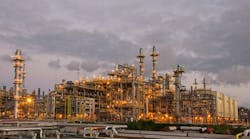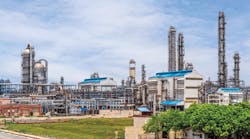Sam Fletcher
Senior Writer
Crude futures prices rocketed to record highs just days after members of the Organization of Petroleum Exporting Countries voted June 15 to raise the cumulative production quota for 10 members, minus Iraq, by 500,000 b/d to 28 million b/d, effective July 1.
In its June 10 report, the Paris-based International Energy Agency pegged production among the 10 quota-limited OPEC members at 27.51 million b/d in May. With Iraqi production included, total OPEC output in May was 29.26 million b/d.
Although US Energy Sec. Samuel Bodman praised OPEC as "responsible and responsive" in boosting its quota, most market analysts dismissed the move as symbolic, not adding any substantial new crude supplies.
"Before the ink [on OPEC's agreement] was even dry, half the ministers were. . .telling the press that the increase would have no effect at all," noted Paul Horsnell, Barclays Capital Inc., London.
Credibility lost
"OPEC has lost all credibility as a guarantor of oil price stability," said analysts at the Centre for Global Energy Studies, London, in a June 20 report. Instead, they said, members of the now "more confident" OPEC "seem comfortable in testing the limits to which they can push oil prices without triggering a reaction from consumers."
OPEC members authorized an additional quota hike of 500,000 b/d if crude prices do not fall prior to their Sept. 19 meeting. They implemented June 16 a new reference basket of 11 benchmark crudes, including Saharan Blend from Algeria; Minas, Indonesia; Iran Heavy; Basra Light, Iraq; Kuwait Export; Es Sider, Libya; Bonny Light, Nigeria; Qatar Marine; Arab Light, Saudi Arabia; Murban, UAE, in place of the previous Dubai; and BCF 17, Venezuela, in place of the previous Tia Juana. Mexico's Isthmus crude is eliminated from the new basket. As a result, the API gravity for OPEC's new basket is heavier at 32.7°, compared with 34.6º for the previous basket of seven benchmark crudes. The sulfur content of the new basket is higher at 1.77% vs. 1.44% previously. That's in keeping with heavier and sourer incremental crudes that OPEC would bring to market. It also would lower OPEC's basket price by $1.50-2/bbl, Horsnell said.
CGES analysts said the price of OPEC's old basket of seven benchmark crudes averaged more than $52/bbl. The new basket of heavier, sourer crudes of lower value suggests, they said, "a price ceiling of some $50/bbl for the newly defined OPEC basket." The analysts noted that the organization had a price band target with a midpoint half that level until the end of last January.
Prices climb
The July contract for benchmark US light, sweet crudes jumped by 59¢ to $55.57/bbl on the New York Mercantile Exchange the same day that OPEC raised its production quota, climbed by $1.01 in the next session, and shot up by $1.89 to $58.47/bbl June 17, the highest closing price for a near-month contract since NYMEX began trading crude in March 1983. Crude contracts for October through March closed above $60/bbl in that session. Near-month crude contracts were reported trading at all-time highs June 20 on both NYMEX and the International Petroleum Exchange in London.
Unlike previous energy market shocks, the current situation is driven by growing world demand for petroleum products rather than by crude supply shortages.
"For the first 9 days of June, US gasoline demand [averaged] 9.51 million b/d higher than gasoline demand has ever reached for any month," Horsnell said. "The growth rate [from a year ago] is running at 3%, the fastest since March 2004. Distillate demand for June to date is running at 8.1%. There is absolutely no sign of flagging oil demand in the US. Indeed, oil demand growth is actually speeding up.
"In short, the market needs to have a look above $60[/bbl in crude prices] to see if that changes the demand dynamic, because $50[/bbl] has achieved very little in that respect." Moreover, he said, "Saudi Arabia is now the only producer in the world with any significant degree of spare capacity. We would then expect the market to continue to trundle on towards $60[/bbl]."
OPEC said the potential shortage of refining capacity capable of producing enough middle distillates of regulated quality is a key friction point. However, Horsnell denied that higher crude prices are exacerbated by speculation in the futures markets. "In any other market, increased liquidity would be seen as a good thing, but in oil the natural response of politicians in many key consuming countries seems to be to see price discovery as a threat," he said.
(Online June 20; author's e-mail: [email protected])

